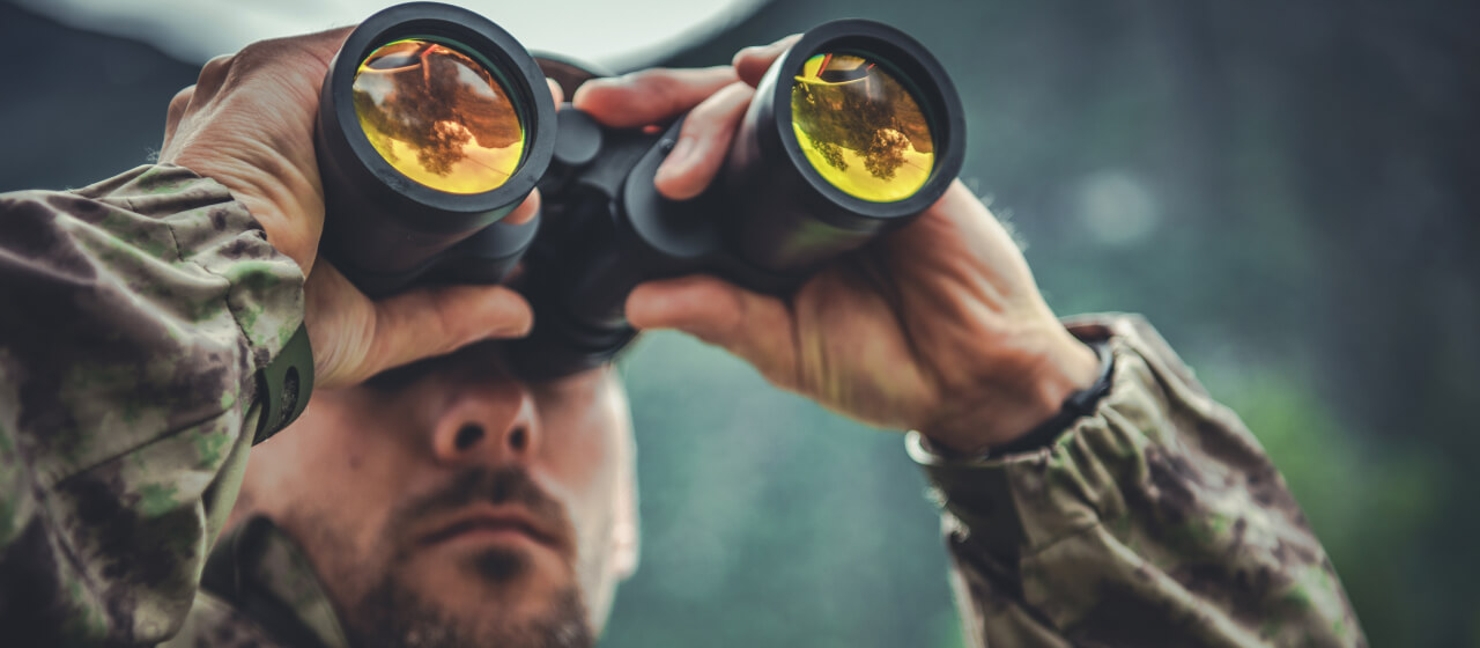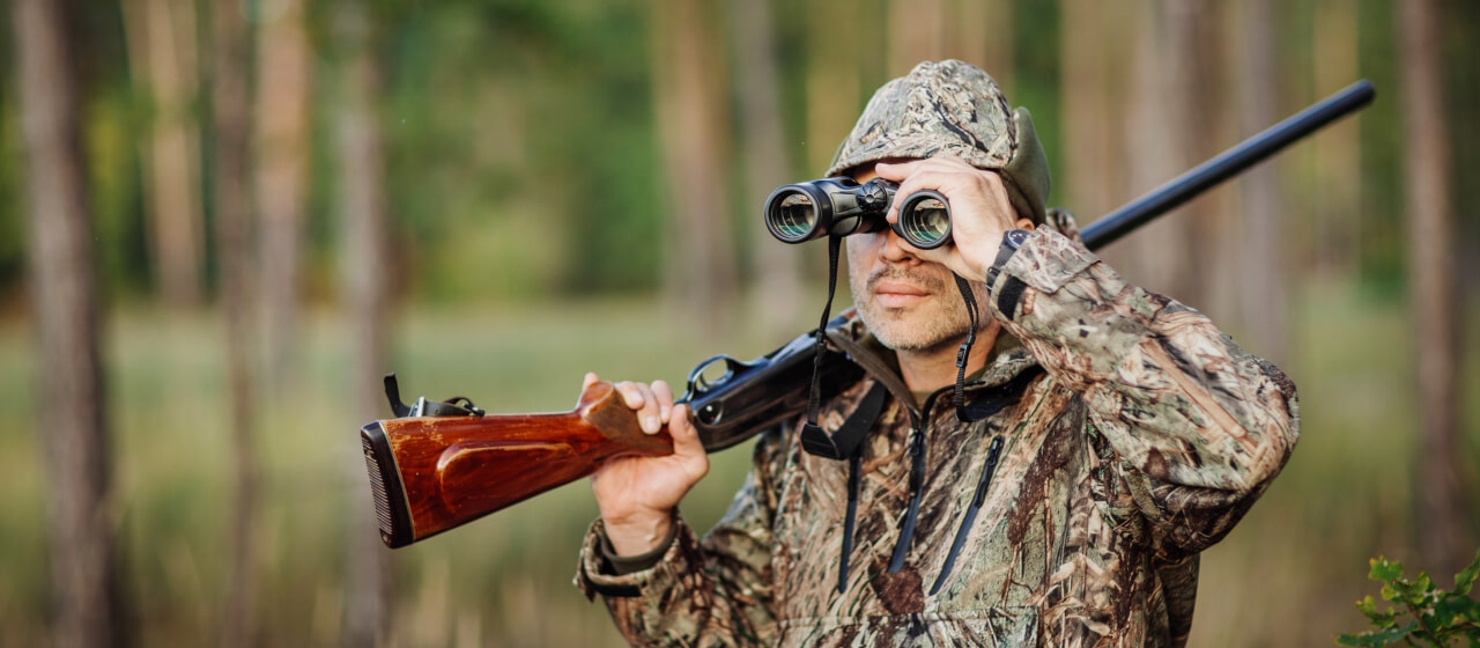How to Choose Binoculars for Bird Watchers, Hunters, Boaters, and More

Binoculars may look like a simple pair of equipment, but they have a number of key features that can change how they perform in a given environment or activity. It’s so important to know where, when, and how you’ll use your binoculars before buying. In this binoculars buying guide, you’ll get our expert advice on the following:
- How to understand binocular specifications
- How to choose binoculars based on outdoor activity
- How to choose binoculars based on environmental factors — like time of day or if you wear glasses
Understanding Binocular Specifications

There are a number of factors to consider when choosing a pair for yourself. Before we get too far into these details, here’s a general overview of the anatomy of binoculars:
- Objective lens: The front-end or bottom-end lens is called the objective lens. Its function is to capture the light as it’s aimed at a subject.
- Ocular lens: The back-end or top-end lens presses against your eye as it refocuses the subject’s image through the internal prism system back to you.
- Center hinge: The center hinge mechanism helps you adjust the binoculars to comfortably fit the distance between each of your eye pupils.
- Focus wheel: As you observe the subject, the wheel between both eyecups helps you to focus the binoculars.
- Diopter: The diopter is simply an adjustable eyepiece usually near the right eyecup. It helps you to accommodate any difference of strength in each of your eyes.
- Eyecups: Eyecups help block out the sun as well as protect your eyes from any direct sunlight while you focus on your subject.
Magnification Power
Magnification power is largely what binoculars are known for, which is their ability to magnify things. Magnification power is always the first number in a binoculars’ size (styled as AxB). The higher the number, the number of times the image in your lens is magnified in comparison to the naked eye. For example, a magnification power of 8 would be 8x the power of an unassisted eye.
Expert Tip:
Always remember that a higher magnification number/power means you’ll have smaller fields of view when you’re choosing a pair of binoculars.
Objective Lens Diameter
Objective lens diameter is always the second number in a binoculars’ size (styled as AxB). The objective lens is the outermost lens of the binocular, and its diameter determines how much light your binoculars gather. The more light, the brighter the image.
Physical Size
While ‘size’ tends to refer to the binoculars’ overall combined magnification power and objective lens diameter, there’s also the physical size and weight to consider. Most binoculars fall into the following physical sizes:
-
Compact binoculars: Less than 30mm objective lens diameter, they are made slim and lightweight, so they’re perfect for slipping into a hiking or hunting pack.
-
Mid-size binoculars: Between 30mm and 40mm objective lens diameters, these are a great compromise between weight and clarity, giving you crisper images without too much heft.
-
Full-size binoculars: Greater than 30mm objective lens diameter, they take in lots of light for high-quality, super-crisp imaging.
Expert Tip:
Looking for just one pair that is the best general performing binoculars or only have room in your budget for one size? Pick up a pair sized to 10x42! This size can take a variety of species and terrains.
Field Of View
Field of view is the width of a viewable area, seen from 1000 yards away. A narrower field of view means you’ll have to scan back and forth more often. It’s a great spec to use if you’re trying to decide between two pairs since the field of view tends to vary dramatically between types of binoculars.

Close Focus
Close focus is the distance between your binoculars and the nearest object that can remain in focus. If you want to see something nearby and (relatively) up close — such as a backyard butterfly, a bird on a telephone wire, or an elk near your hunting stand — pay attention to this specification.
Exit Pupil
Exit pupil is a measurement of the light that reaches your eyes through your binoculars. The higher the number is, the brighter the images you’ll see. This is more important for low- to no-light situations, and less important in bright daylight.
Eye Relief
Eye relief refers to the distance between your binocular’s eyepiece and your eye when your binoculars are properly calibrated — meaning the entire field of view is visible. This is a key specification if you wear glasses, as eye relief does vary between the different makes and sizes of binoculars.
Expert Tip:
Glasses wearers should look at binoculars that allow for a minimum of 15mm or more for eye relief.
Types of Binoculars by Use Case

Hunting
Binoculars are an essential part of a hunting gear checklist and do more than just help you spot your game. They also help you locate other hunters, survey the land, and conserve energy — since you’re not hiking around to look at things or check snares.
While most hunters will want to find a pair that splits the difference between power and weight, as with all hunting gear, figuring out how to choose binoculars for hunting depends on the game you’re after.
| Hunting Binoculars Overview | ||||
|---|---|---|---|---|
Hunting Type |
Description |
Important Feature Considerations |
Sizes To Look for |
Our Pick |
| Deer Hunting | Higher magnification power makes it easier to spot deer from your vantage point. Anything above 10 power might be difficult to hold for long periods of time, so consider adding a tripod to your pack to help support. |
|
10x42 |
Vortex Diamondback HD 10 x 42 Binoculars |
| Turkey Hunting | Certain binoculars may also have a red-tinted glass that may help keep turkeys from spooking at the sight of your lens. |
|
8x42 10x42 |
Vortex Eagle HD Camo 10x42 Truetimber Prairie Binoculars |
| Elk Hunting | A compact, lightweight pair here will be extra important, given that elk hunting requires much more walking than your standard deer hunt. |
|
8x42 10x42 |
Vortex Crossfire HD 8 x 42 Binoculars |
| Duck Hunting | Make sure to invest in a water- or weatherproof pair of binoculars if you plan to duck hunt. You may also benefit from a pair with tinted glass. |
|
8x42 10x42 |
Redfield Rebel 10 X 42 Roof Prism Binoculars |
Other Activities
The beauty behind binoculars is their flexibility! Beyond hunting, there are a few other popular activities and use cases to consider. Below is a summary and an overview of these activities:
- Bird-watching: While you certainly could go bird-watching without a pair of binoculars, you wouldn’t have nearly as much fun without them.
- Hiking: Using binoculars while hiking or backpacking can help you check out the trail ahead and take in more of all that nature has to offer.
- Sporting Events: If you frequently find yourself up in the bleachers, a pair of binoculars can make sure you don’t miss a moment of the action.
- Boating: Even landlubbers know that water is never perfectly flat, so be sure to stick to lower-power binoculars to avoid seasickness while looking for land, obstacles, or your perfect fishing spot.
| Other Activity Binoculars Overview | ||||
|---|---|---|---|---|
Activity Type |
Description |
Important Feature Considerations |
Sizes To Look for |
Our Pick |
Bird Watching |
While birds certainly are small, they also move around a lot. Eight-power magnification gets you a wider field of view, making it easier to learn how to track a bird’s movement and location in your lenses. |
|
8x32 8x42 |
Bushnell Prime Roof Prism 8 x 32 Binoculars |
| Hiking | On the trail, size, and weight means everything, so make sure you find a pair that doesn’t take up too much space in your pack (or make it too heavy). Rubber coating or anti-scratch lenses can withstand tougher terrain. |
|
10x25 8x28 10x28 |
Nikon Aculon A30 10 x 25 Binoculars |
Sporting Events |
A higher, 10-power magnification can help make sure you pick up on all the details. A wide field of vision will also help make sure you’re not missing any crucial passes, so a mid-size pair of binoculars can also work great. |
|
8x32 8x42 10x32 10x42 |
Vortex Crossfire HD10x42 Binocular |
| Boating | Fully waterproof will give total peace of mind if you’re worried about it getting splashed or a quick dunk. Binoculars don’t float! Weather-proofed pairs will make sure your lenses survive the occasional rain, mist, spray, or fog. |
|
8x32 8x42 |
Celestron Ultima 8 x 42 mm Porro Binoculars |
Other Considerations
The environments you go in as well as other personal considerations definitely impact the type of binoculars you’ll need and choose. The following are the most popular conditions and considerations:
- For Low Light: In dark situations, full-size binoculars really shine due to their large lenses. The bigger the lens, the bigger its ability to capture light. Full-size binoculars also tend to have higher magnifications and exit pupil measurements, which can help if you’re trying to make out details that tend to get obscured in low light.
- For Fog: Fog-proof binoculars are filled with nitrogen gas to prevent internal fogging — think when you quickly move from somewhere cool to somewhere warm — and then sealed to ensure it won’t escape. This typically won’t protect it from external fogging if the environment itself is foggy.
- For Glasses-wearers: If you wear glasses, you’ll want to pay close attention to the eyepieces of your binoculars.
| Other Considerations Binoculars Overview | ||||
|---|---|---|---|---|
Use Type |
Description |
Important Feature Considerations |
Sizes To Look for |
Our Pick |
For Low Light |
Anything higher than 10 power can sometimes be hard to hold for long periods of time, so consider adding a tripod. |
|
10x42 10x50 |
Vortex Crossfire HD 10 x 50 Binoculars |
| For Fog | If you live somewhere misty, be sure to invest in a water- or weatherproof pair. |
|
- |
Redfield Renegade 10 x 50 Porro Prism Binoculars |
| For Glasses Wearers | You’ll want to look for an eye relief measurement of at least 11mm and up to 20mm. Most binoculars have adjustable eyepieces, so you’ll have room to find your perfect fit. |
|
- |
Vortex Crossfire HD 12x50 Binocular |
Have Fun Out There
Before you make your first binoculars purchase, make sure you’re comfortable with their weight, feel, and focusing ability. You may encounter other, high-tech specifications that may influence your purchase, but it’s up to you how many bells and whistles you need starting out.
Feel free to test out our variety of binoculars in-store at your
local Academy Sports +Outdoors
. You can also browse
our online binoculars selection
to get a better idea of what could work best for your future outdoor fun.